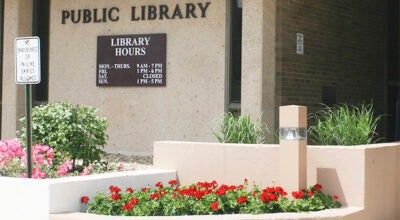Seeking Minn. star authors? There’s a map for that
Published 6:55 pm Saturday, August 10, 2013
By Mary Ann Grossman, St. Paul Pioneer Press
ST. PAUL — You’re driving through a Minnesota town that has a familiar name.
“Didn’t an author live here?” you ask your companion.
Now you can answer that question by using “From Main Street to Your Street: Minnesota Writers on the Map.”
This handsome new free literary map was created by the Minnesota Historical Society and Friends of the St. Paul Public Library to celebrate the Minnesota Book Awards’ 25th anniversary.
The illustrated, two-sided map features information about 112 authors, including birthplaces, dates of births and deaths and book titles.
“We’re seeing a resurgence in maps because of the literary tourism movement,” said Patrick Coleman, MHS acquisitions librarian. “I’ve been a voice crying in the wilderness for years for a project like this, a map with good content that looks nice.”
Coleman’s partner on the $25,000 project was Alayne Hopkins, director of Friends’ programs and Minnesota Book Awards, which are administered by the Friends.
“This map is a wonderful sample of the literary legacy in this state,” Hopkins said. “I love the fact that you can find authors on it from William Joseph Snelling to Kate DiCamillo.”
“Minnesota Writers on the Map” is big. It measures 3 feet by 2 feet to mimic a real road map — and that fits the idea of literary tourism.
Colored in rich greens, browns and cream, the map is dotted with playful caricatures of 51 authors created by St. Paul graphic artist/illustrator Chad Nestor. One side of the map shows the entire state; the other side features a smaller map of authors in the metro area as well as information about all the authors, divided into six regions.
In the Arrowhead, you’ll find Helen Hoover. Scoot way to the west, and there are the Treuers — Anton, David and Robert. Drop down south, and Fred Manfred dwells in the Blue Mounds. Head back east to locate Frances Densmore in Red Wing.
Minnesota’s literary lights are on the map, including F. Scott Fitzgerald, Sinclair Lewis, J.F. Powers, Maud Hart Lovelace and Garrison Keillor.
But less well-known writers are recognized, too. There’s Patrick Cudmore, who wrote “The Irish Republic: A Historical Memoir on Ireland and Her Oppressors.” There’s Walter O’Meara, author of the novel “Minnesota Gothic,” and children’s author Emma Brock.
“I take it as my personal mission to bring to the forefront forgotten authors,” said Coleman, who’s renowned for carrying in his head the names and book titles of hundreds of Minnesota writers.
Coleman points out there have been at least three previous Minnesota literary maps, but none as detailed or attractive as “From Main Street to Your Street.”
The partnership between the Friends and MHS began with Lori Williamson, MHS acquisitions/outreach coordinator, who heard about the map idea during a meeting of the Book Awards steering committee.
“It seemed like the right time for the Historical Society to team up with the Friends because we had beefed up the biographies of about 35 authors in our files several years ago,” said Williamson, who knows there is “huge interest” among the public in learning about authors and their books. She often answers questions about writers when she works the Minnesota History Center’s reference desk, and web analytics show author information is one of the Historical Society’s most popular library pages.
When Williamson shared the map idea with Coleman, he couldn’t have been happier.
“Lori has listened to me whine about a map for years,” he said with amusement. “I was happy to help in any way possible.”
Coleman began by making a list of authors he thought should be on the map. He came up with 2,300 names. You read that right: 2,300.
“The hardest part of the map project was the number of authors we could have included,” he admitted. “It couldn’t be too crowded or it would not be visually appealing. I feigned hurt when Alayne let me have only 100.”
Coleman says choosing map-worthy authors was partly subjective.
“We looked at the writers’ staying power, importance, whether in their time they were thought to be literary giants. For me personally, these are the authors who deserve broader recognition, those you need to read if you want to participate in our culture.”
When the authors were selected, Nestor came on board.
“This project sounded like great fun. I’m a bit of a nut for maps in general, and this is map-ish, even though it’s not used to find your way around the state,” said Nestor, owner of St. Paul-based Nestor Designs.
For the Minnesota literary map, he used photos to do sketches of the authors. Then he decided to go a step further and add little iconic images that evoke their books.
There’s Wanda Gag surrounded by felines (“Millions of Cats”). Birds fly around Louise Erdrich (“The Plague of Doves”). A Thunderbird perches above Jim Northrup (“Walking the Rez Road”). Stars circle politician/poet Eugene McCarthy.
One of the first enthusiastic responses to the map came from Ann Hutton, executive director of Rochester-based Southeastern Libraries Cooperating, which represents libraries in 12 counties.
Hutton distributed 3,000 copies to public and academic libraries and schools, and she says they are a hit.
“The map has enough information to pique interest but it’s whimsical enough so you don’t feel you are taking ‘Intro to Minnesota Literature 101,’ although that’s exactly what you are doing,” Hutton said.
She’s seeing people use the map in a variety of ways.
“At one regional library, they put the map on a bulletin board and asked people to stick a pin in a location they’ve been to,” she said. “A couple of book clubs are looking at reading some of the titles by authors who lived in the area, and others are thinking about day trips or even overnight travel to destinations on the map.”
Joan Hummel, communications manager for Explore Minnesota, says those travel plans are what the agency hoped for when they partnered with the Friends for the first time.
“The Friends thought there was a tourism angle to the map, and we agreed,” Hummel said. “It was a great opportunity to get the word out about the map and literary tourism in general. The time was ripe because Minnesota has so many authors.”
Besides a $2,500 grant to the project, Explore Minnesota mentioned the map in its June e-newsletter, which goes to about 400,000 readers.
Hummel says literary tourism is a niche market that isn’t new for towns that have figured out a way to capitalize on their homegrown authors. Sauk Centre, for instance, promotes Sinclair Lewis. Tiny Walnut Grove welcomes visitors from as far away as Japan who come to see one of Laura Ingalls Wilder’s homes.
But Hummel says books also can have an indirect impact on literary tourism.
“When I read mysteries by William Kent Krueger that are set in northeastern Minnesota, I think of the Ely area and it makes me want to go there,” she said. “Overall, I think projects like the literary map add to our reputation as a cultural destination and generate interest in Minnesota. It raises our profile as a literary resource.”
Link to literary map: thefriends.org/litmap.




